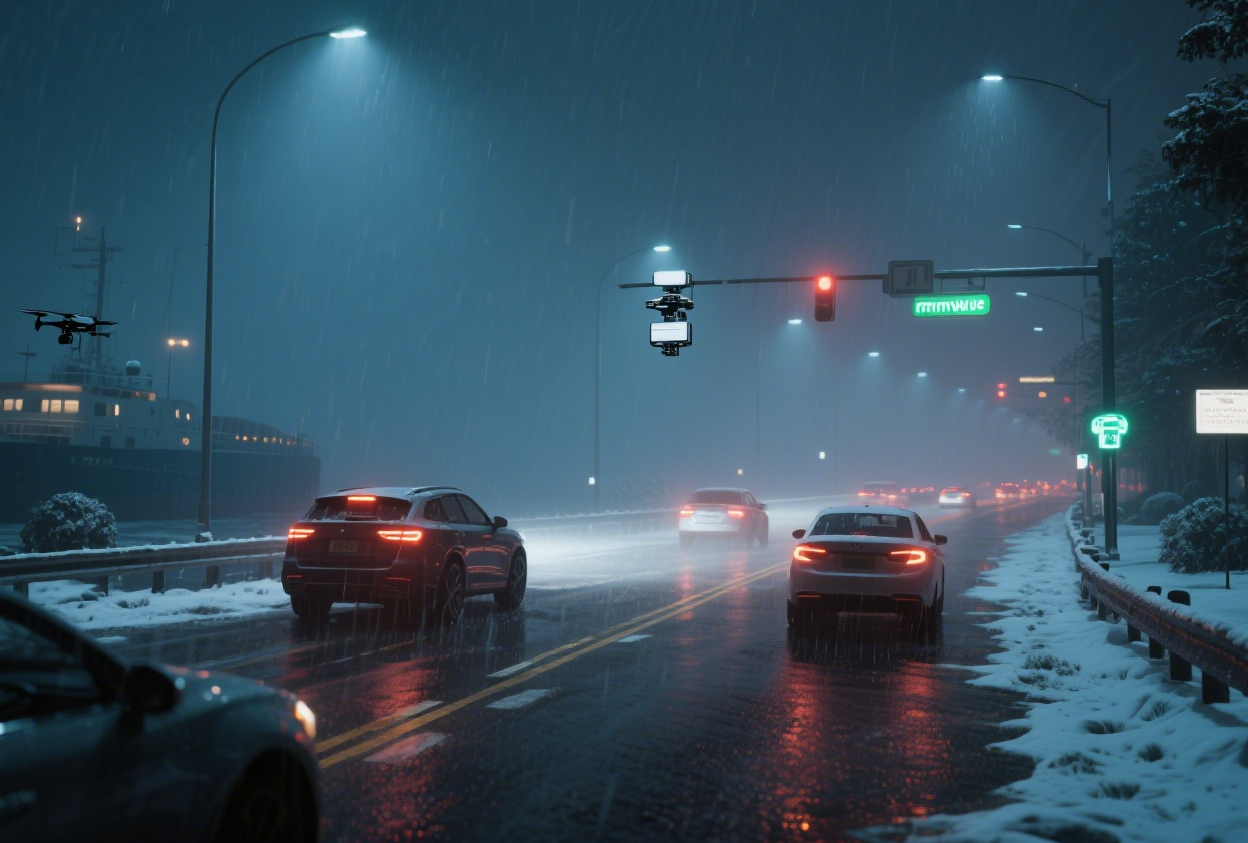Reliable sensing in challenging weather and lighting conditions has always been a key concern for traffic management, autonomous vehicles, drones, and security systems. Cameras, LiDAR, and infrared sensors can struggle in rain, fog, snow, or darkness, leading to blind spots or inaccurate measurements. Millimeter-wave (mmWave) radar, however, provides a robust alternative, enabling continuous, accurate detection in conditions that would compromise traditional sensors.
1. Why Adverse Weather Is a Challenge
-
Cameras: Performance drops significantly in low visibility; raindrops, fog, or snow can distort images and reduce detection accuracy.
-
Infrared sensors: Sensitive to thermal reflections and may fail in heavy precipitation or when surface temperatures are uniform.
-
LiDAR: Light-based detection suffers from scattering and absorption by fog, snow, or rain, causing reduced range and false readings.
In contrast, mmWave radar operates in the 76–81 GHz frequency band, where wavelengths are millimeter-scale, allowing the signal to partially penetrate rain, fog, and snow.
2. Performance Advantages of mmWave Radar in Rain, Fog, and Snow
-
Rain penetration: While heavy rain can cause slight signal attenuation, mmWave radar maintains accurate range and velocity detection for vehicles or obstacles within its effective distance.
-
Fog and mist tolerance: Unlike optical sensors, radar is largely unaffected by visibility, providing reliable measurements even when visibility drops below 50 meters.
-
Snow and hail: Snowflakes create minimal scattering for mmWave signals. Although detection range may be slightly reduced, radar continues to detect objects with high confidence.
Practical insight: Systems deployed in areas with frequent adverse weather can maintain monitoring continuity without relying solely on cameras.
3. Night and Low-Light Performance
-
Cameras require supplementary illumination or infrared lighting for night operations, which may still be affected by glare or shadows.
-
mmWave radar does not depend on visible light, allowing 24/7, all-weather operation.
-
Benefits for traffic systems: Continuous vehicle tracking, speed measurement, and occupancy detection are possible regardless of ambient lighting.
4. Expanded Application Scenarios
4.1 Smart Traffic Systems
-
Use case: Highways prone to fog, rainy city streets, or tunnels.
-
Benefit: Lane-by-lane vehicle monitoring and speed measurement continue uninterrupted, enabling adaptive traffic light control and automated enforcement even in poor visibility.
4.2 Autonomous Vehicles and Drones
-
Use case: Low-altitude drones or self-driving vehicles navigating in rain, fog, or night.
-
Benefit: Collision avoidance and navigation rely on radar rather than optical sensors, improving operational safety.
4.3 Ports and Maritime Applications
-
Use case: Docking or maneuvering ships in rainy or foggy conditions.
-
Benefit: Radar provides reliable short-range detection for vessels, preventing collisions where cameras or LiDAR may fail.
4.4 Security and Perimeter Monitoring
-
Use case: Nighttime or stormy weather intrusion detection.
-
Benefit: Radar sensors detect moving targets reliably, complementing cameras which may be blinded by darkness or precipitation.
5. FAQ (Frequently Asked Questions)
Q1: Will mmWave radar fail completely in heavy rain or snow?
A1: No. While extreme conditions can slightly reduce range, radar maintains detection capability. Algorithms can compensate for signal attenuation.
Q2: Can mmWave radar replace cameras entirely?
A2: Not entirely. Radar is best used in sensor fusion with cameras and LiDAR, providing complementary all-weather perception.
Q3: Is additional protective housing required?
A3: Yes. IP67 or IP68 rated enclosures ensure reliable operation in rain, snow, and high humidity environments.
Q4: How about detection range in fog or heavy precipitation?
A4: Typically, mmWave radar retains 70–90% of nominal range in moderate fog/rain; extreme weather reduces range slightly, but detection remains stable.
6. Deployment Recommendations
-
Mounting location: Avoid pointing antennas directly at areas prone to water pooling or snow accumulation.
-
Protective design: Ensure enclosures prevent water ingress and condensation inside the radar unit.
-
Integration: Combine mmWave radar with cameras or LiDAR for sensor fusion, enhancing perception in all conditions.
-
Calibration: Regularly validate performance under local weather conditions to adjust detection thresholds if needed.
-
Maintenance: Even with robust weather tolerance, routine inspection of antenna surfaces and signal processing units ensures long-term reliability.
7. Conclusion
Millimeter-wave radar excels in adverse weather and low-light environments, providing reliable detection when cameras, LiDAR, or infrared sensors struggle.
From urban traffic management and autonomous vehicles to maritime operations and perimeter security, mmWave radar ensures continuous, high-accuracy perception in rain, fog, snow, or darkness. Deploying mmWave radar alongside traditional sensors enables robust, all-weather intelligent systems, minimizing blind spots and improving operational safety.



